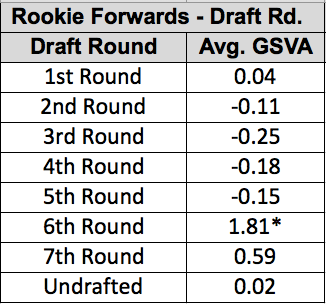2019-20 NHL GSVA - Rookie Forwards
- Ken Beckett

- Apr 15, 2020
- 3 min read

As the 2019-20 season remains paused due to the COIVD-19 pandemic, this is my first foray into posting about something near and dear to me: hockey analytics. With the extra time and a background in hockey analytics, I wanted to look deeper into issues that I find interesting. So with that, for my first post I wanted to look at Game Score Value Added (GSVA) among rookie forwards this season.
Much like wins above replacement (WAR) in baseball, GSVA is a valuable tool to find out how a player impacts the lineup. Created by Dom Luszczyszyn of The Athletic, GSVA puts a quantitative value on a player's worth in lineup, and takes into account the following variables in the equation:
Goals: 0.75
Primary Assists: 0.7
Secondary Assists: 0.55
Shots: 0.075
Blocks: 0.05
Penalty Differential: 0.15
Faceoff Differential: 0.01
5-on-5 Corsi Differential: 0.05
5-on-5 Goal Differential: 0.15
All of the 2019-20 data is from games played and comes from Dom's database that tracks GSVA back to 2007. With that, some rookies have played more games than others and to avoid any outliers, I have only included rookies who have played more than ten games this season. This left me with 68 forwards to collect GSVA and corresponding data for.
With that, here is a scatterplot showing the most and least successful players as far as GSVA during the 2019-20 season:

The top five rookie forwards in game score value added are:
1. Dominik Kubalik (CHI) - 1.37
2. Victor Olofsson (BUF) - 1.14
3. Denis Gurianov (DAL) - 0.94
4. Nick Suzuki (MTL) - 0.93
5. Ilya Mikheyev (TOR) - 0.74
Rookie Forward Average: -0.01
For comparison's sake, the top GSVA in the league this season for forwards belonged to both Artemi Panarin of the New York Rangers and Colorado Avalanche forward Nathan MacKinnon at 4.13, while David Pastrnak of the Boston Bruins was close behind at 4.11.
I also wanted to break these numbers down and see how GSVA ranked among different variables. The first I looked at was birth year to see if the age of the rookies had an impact on GSVA.

Based on this data, one could make the logical conclusion that the older the rookie and thus more time in junior, overseas, or in the AHL developing is helpful as the two highest ranks came from players born earlier in 1994 and 1995.
Following up on that, I looked at where the players were taken in the draft to see how the average GSVA correlated to where a player was taken.

* - Victor Olofsson (BUF) only player taken in sixth round.
From looking at this data, aside from Olofsson's outlier in the sixth round, the highest totals come from seventh round picks at 0.59, which might correlate with my observation above that lower picks spend more time developing in junior and in the minors which makes them more impactful as rookies. That is followed up by first round picks, which are heavily weighed down by Kaapo Kakko's -1.35 GSVA (lowest among rookie forwards to have played over ten games).
With depth obviously playing a key role and as such, scouting and drafting being key to identify these late round picks, I next looked at where the rookies played junior.

Leading the way were forwards from the Czech Republic, Russia, and then the Ontario Hockey League (OHL). There was a small sample size from Czech players with only two players in rookie-leader Dominik Kubalik and Carolina Hurricanes forward Martin Necas (0.29). Next up were Russian forwards lead by Gurianov (0.94) and Mikheyev (0.74), while the remaining three were in the negatives. They were followed up by OHL forwards with an average GSVA of 0.07, lead by Suzuki (0.93), Ottawa Senators rookie Logan Brown (0.15), and Philadelphia Flyers forward Connor Bunnaman (0.11).
Finally, the last area that I broke down GSVA by category was by position, which can be seen below:

It is widely acknowledged that centre is the hardest position to play, especially for a young player new to the league, so it is perhaps not surprising that it is the only position in the negatives, while left wing leads the way. This is buoyed by Kubalik's outlier of a GSVA at 1.37.
After analyzing GSVA's for rookie forwards in 2019-20, some interesting but logical conclusions can be made that older players with more time to develop in junior and the minors seem to be more successful, thus resulting in a higher GSVA. While forwards from the OHL as well as European countries such as Sweden, Russia, and the Czech Republic were the most impactful in their rookie seasons during the 2019-20 campaign.

Comments